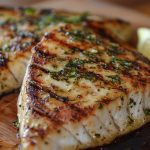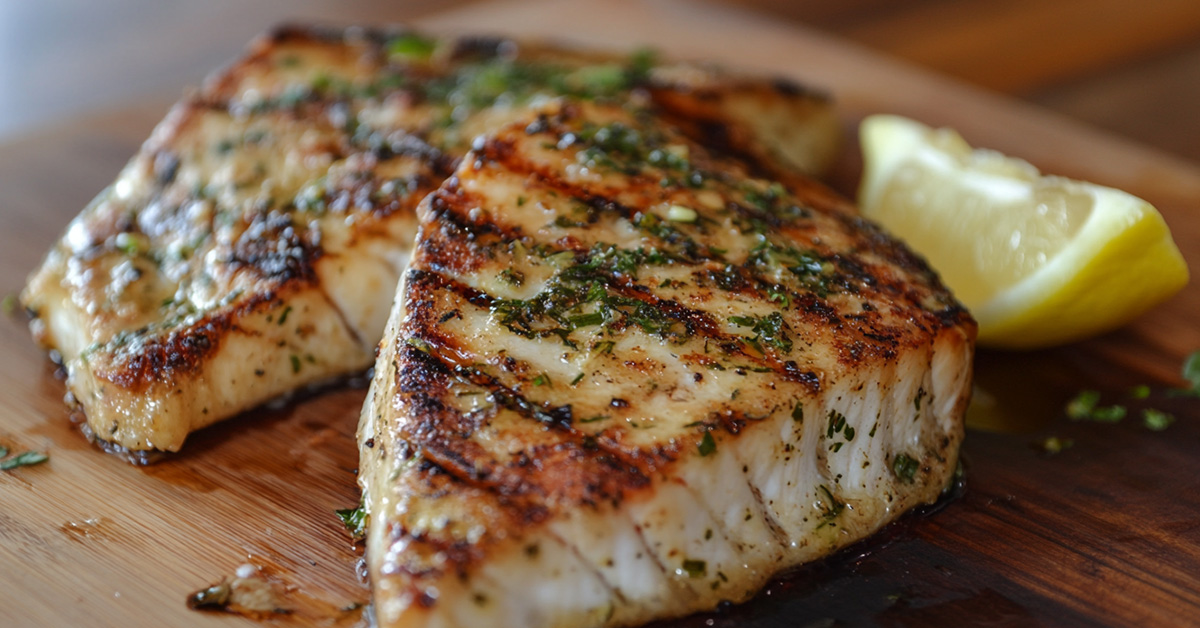Disclosure: As an Amazon Associate and participant in other affiliate programs, we earn from qualifying purchases. We only recommend products we believe will provide value to our readers.
A great opah recipe can reshape your seafood dining experience completely. This unique fish stands out with its rich, buttery flavor and firm texture that makes it more versatile than most seafood options.
The guide helps you create amazing dishes whether you’re learning about opah fish recipes for the first time or want to become skilled at grilling techniques. You’ll learn everything from picking the freshest cuts to cooking this prized catch perfectly.
We’ll show you expert techniques and proven recipes that deliver delicious results consistently. The guide includes essential tools, perfect side dish combinations, and great tips to improve your opah cooking skills.
Table of Contents
What Makes Opah Fish Special?
As you plan your next opah recipe adventure, you’ll quickly find what makes this magnificent fish stand out in the culinary world. People call it the “moonfish,” and opah has unique traits that make it different from other seafood choices.
Opah’s remarkable versatility in the kitchen makes it special. Most fish give you just one type of meat, but opah gives you different textures and flavors from various parts of the same fish:
- The top loin offers a rich, beef-like texture perfect for grilling.
- The bottom fillet provides a lighter, more delicate taste ideal for pan-searing.
- The belly meat presents a buttery consistency like salmon.
- The cheeks offer the most prized and tender portions.
You can cook opah almost any way you want because its firm texture holds up well. The meat stays together whether you grill it or pan-sear it. You don’t need to worry about it falling apart.
This fish’s high oil content keeps it moist and flavorful even if you cook it too long. Beginners and expert chefs love this forgiving nature. Its pink to orange-red flesh looks amazing on the plate and has a mild, clean taste that works great with both bold and subtle seasonings.
Choosing the Perfect Opah Fish for Your Recipe
The right fish selection is a vital part of any successful opah recipe. At the time you visit the market or fish counter, expertise in selection can transform a good dish into an exceptional meal.
Fresh opah should display these characteristics:
- The flesh should be firm and spring back when pressed.
- A whole fish‘s eyes must be bright and clear.
- A clean ocean scent without any strong fishy smell.
- The skin needs to be moist and shiny without dry spots.
- The flesh should have vibrant pink to orange-red colors.
Your opah recipe’s success depends on the cut’s thickness. A thickness between 1 to 1.5 inches will give a perfect cook whether you plan to grill or use other preparation methods.
Storage matters as much as selection. After picking your perfect cut, store it in the refrigerator below 40°F. The best results come from using it within 1-2 days, but make sure to wrap it tightly in plastic if not cooking right away.
The portion size needs careful thought. Plan about 6-8 ounces per person. This amount covers your recipe needs and accounts for any trimming during preparation.
Quality opah costs more than other fish options, and with good reason too. A reputable seafood vendor who shares the fish’s origin and handling details is a great way to get recipe success. Their knowledge can make all the difference in your dish.
Essential Tools for Cooking Opah Fish Recipes
The right kitchen tools will make a big difference in preparing your perfect opah recipe. You’ll need these items ready before you start cooking to create a smooth culinary experience.
Simple Kitchen Equipment:
- A reliable instant-read thermometer for monitoring internal temperature.
- Heavy-duty tongs for handling the fish.
- Sharp fillet knife for precise cutting.
- Large cutting board with juice groove.
- Kitchen scale for portion control.
- Heavy-bottom stainless steel pan for searing.
Your grilled opah recipe needs these additional grilling essentials:
- Fish basket or sturdy fish spatula.
- Grill brush for cleaning.
- Spray bottle for controlling flare-ups.
- Heat-resistant gloves.
Your recipe’s success also depends on proper preparation tools. A good set of measuring spoons and cups will give accurate seasoning measurements. A citrus juicer works great for fresh marinades. You might want to invest in a fish skin scraper if you plan to cook with the skin on.
Storage and Cleaning equipment plays a vital role too. Keep food-grade storage containers handy for leftovers. Kitchen towels and paper towels should be nearby for quick cleanups. A dedicated fish cutting board prevents cross-contamination and stops unwanted flavors from transferring to other foods.
Note that many delicious opah dishes need just simple kitchen equipment. Start with versatile tools that serve multiple purposes. You can add specialized items later as you try more complex recipes.

Opah Recipe
- Total Time: 20 minutes
- Yield: 2–4 people 1x
Description
Turn your fresh opah into a mouth-watering grilled dish with this simple yet elegant recipe that highlights the fish’s natural buttery flavor.
This grilled opah recipe pairs the fish’s rich texture with a light herb-garlic butter finish. The result is a perfectly balanced dish that’s impressive yet easy to make. Your grill’s high heat locks in moisture while creating beautiful marks and enhancing the fish’s natural taste.
Ingredients
- 4 opah steaks.
- Salt to taste.
- 4 tablespoons garlic and herb butter.
- 1 fresh lemon for serving.
- Olive oil for brushing.
Instructions
- Pat the opah steaks dry and season both sides generously with salt.
- Preheat your grill to medium-high heat.
- Brush the grill grates with oil to prevent sticking.
- Place the opah on the hottest part of the grill.
- Grill for 3-4 minutes on the first side.
- Flip and cook for an additional 3-4 minutes until cooked through.
- Top each steak with a pat of garlic herb butter right after removing from heat.
Notes
- You’ll get perfect grill marks by rotating the fish 90 degrees halfway through cooking each side.
- The internal temperature should reach 125°F for medium-rare.
- Watch your cooking time – overcooked fish becomes dry.
- Let the fish rest 2-3 minutes before serving.
- Prep Time: 5 minutes
- Cook Time: 15 minutes
- Category: Seafood
- Method: Grilling
Health Benefits of Opah Fish
Opah isn’t just delicious and versatile – it’s packed with health benefits too. This amazing fish combines great taste with powerful nutrients.
Key Nutritional Benefits you’ll get at the time you cook your favorite opah recipe:
- High-quality lean protein that maintains muscle health.
- Omega-3 fatty acids that keep your heart healthy.
- Essential minerals like selenium and phosphorus.
- B-vitamins that boost energy metabolism.
- Low calories that still leave you feeling full.
Your cooking method can substantially affect your opah’s nutritional value. Healthier cooking methods like grilling or pan-searing with minimal oil help preserve the fish’s natural benefits and keep extra fats low.
Grilling opah works great because the excess fat drips away during cooking. This makes it perfect for anyone watching their health. The fish keeps its natural oils while cooking, so you get all the nutrients along with amazing flavor.
The meaty texture of opah helps you feel full with smaller portions. This makes it perfect for anyone watching their calories but still craving a filling meal. You can create balanced, healthy meals by pairing your opah with fresh vegetables and whole grains.
References:
– hawaii-seafood
– fisheries
Tips for Grilled Opah Recipe Perfection
Become skilled at grilling opah with these expert tips that will raise your seafood cooking game. A perfect grilled opah recipe depends on your preparation and technique.
Temperature Management is a vital part of your opah fish recipe success. The fish should reach room temperature 30 minutes before grilling. This will give a consistent cook and stops the fish from sticking to the grates. Your grill should stay at medium-high heat (around 375-400°F) while cooking.
These pro grilling tips will help you achieve great results:
- Brush the fish with high-heat oil just before grilling.
- Create crosshatch marks by rotating 45 degrees halfway through.
- Keep the lid closed between flips to maintain temperature.
- Use a fish spatula rather than tongs for turning.
- Let the fish rest on a warm plate after grilling.
Your Seasoning Strategy makes a significant difference in the recipe’s success. Salt is essential, but too much seasoning can overpower the fish’s natural flavors. A light brush of herb-infused oil before grilling adds depth without overwhelming the delicate taste.
The flesh becomes increasingly opaque from the bottom as it cooks. The fish needs flipping when this change reaches about halfway through its thickness. Note that opah continues cooking for a few minutes after you remove it from heat. A slightly underdone fish is better than an overcooked one.
Read also: Grilled Dorado Fish Recipe
Mastering the Pan-Seared Opah Recipe
Pan-searing enhances your opah fish recipe by creating a golden-brown crust while keeping the interior tender and moist. This technique serves as a perfect alternative to grilling, especially at the time weather or equipment limitations affect your cooking plans.
Start with the right preparation. Your pan needs to be heavy-bottomed and preheated until it’s hot enough. A cast-iron skillet’s consistent heat makes it an excellent choice for your opah recipe throughout the cooking process.
These steps will give you perfect pan-seared results:
- Pat the fish completely dry before seasoning.
- Use high-heat oil like grapeseed or avocado.
- Let your pan get smoking hot before adding the fish.
- Press gently with a spatula to ensure even contact.
- Don’t move the fish too early.
Your success with pan-seared opah depends on timing and temperature control. Cook for 4-5 minutes on the first side until a golden-brown crust forms. The color should be deep amber, not dark brown. Reduce the heat slightly after flipping to prevent overcooking and ensure the center reaches the right temperature.
Watch for visual cues as your opah cooks. The flesh’s color changes from the bottom up and becomes opaque. Flip the fish once this change reaches halfway through its thickness. A gentle finger press should meet slight resistance – this shows perfect doneness.
Note that pan-searing intensifies flavors through caramelization, so adjust your seasoning. Use herbs and spices lightly to let your opah’s natural buttery flavor shine through while enhancing the beautiful crust you’ve created.
Pairing Opah Recipes with Side Dishes
Lift your opah recipe experience by selecting perfect side dishes that complement this versatile fish. Success in pairing comes from balanced flavors that enhance your opah preparation’s natural richness.
Light and Fresh Companions pair beautifully with your opah fish recipe. A crisp Asian-inspired slaw or bright citrus salad cuts through the fish’s natural richness. These refreshing sides especially complement a grilled opah recipe and balance its smoky flavors.
Your ultimate dining experience awaits with these proven pairings:
- Roasted rainbow vegetables with fresh herbs.
- Quinoa pilaf with toasted pine nuts.
- Grilled asparagus with lemon zest.
- Mediterranean couscous salad.
- Garlic-sautéed baby bok choy.
A pan-seared opah dish calls for heartier accompaniments that match its robust character. A bed of creamy risotto or roasted fingerling potatoes creates a satisfying foundation for your plate.
Seasonal Considerations shape your side dish choices naturally. Summer months call for grilled corn salad or fresh herb-dressed vegetables. Cooler weather demands roasted root vegetables or wild mushroom medley that complement the fish’s meaty texture.
Note that your main dish’s sauce or seasoning should guide your side dish selection. Bold flavors in opah preparation pair best with simple accompaniments that won’t compete for attention on the plate.
You may like also: Grilled Ono Fish Recipe













